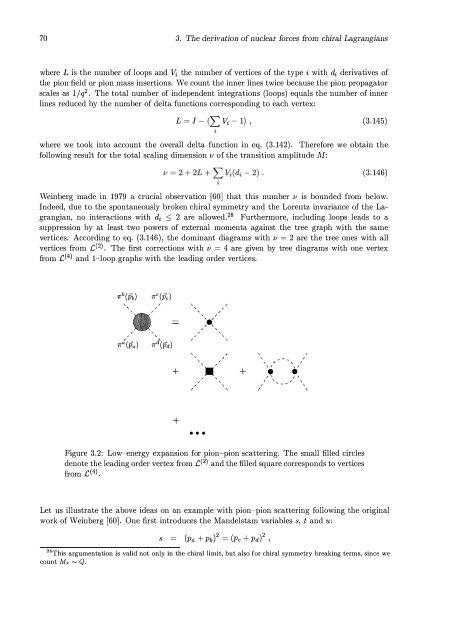The Nucleon-Nucleon Interaction in a Chiral Effective Field Theory
The Nucleon-Nucleon Interaction in a Chiral Effective Field Theory
The Nucleon-Nucleon Interaction in a Chiral Effective Field Theory
Create successful ePaper yourself
Turn your PDF publications into a flip-book with our unique Google optimized e-Paper software.
70 3. <strong>The</strong> derivation of nuclear forces from chiral Lagrangians<br />
derivatives of<br />
the pion field or pion mass <strong>in</strong>sertions. We count the <strong>in</strong>ner l<strong>in</strong>es twice because the pion propagator<br />
scales as 1/ q2 . <strong>The</strong> total number of <strong>in</strong>dependent <strong>in</strong>tegrations (loops) equals the number of <strong>in</strong>ner<br />
l<strong>in</strong>es reduced by the number of delta functions correspond<strong>in</strong>g to each vertex:<br />
where L is the number of loops and Vi the number of vertices of the type i with di<br />
L = 1 - (2: Vi - 1) , (3.145)<br />
where we took <strong>in</strong>to account the overall delta function <strong>in</strong> eq. (3.142). <strong>The</strong>refore we obta<strong>in</strong> the<br />
follow<strong>in</strong>g result for the total scal<strong>in</strong>g dimension LI of the transition amplitude M:<br />
(3.146)<br />
We<strong>in</strong>berg made <strong>in</strong> 1979 a crucial observation [60] that this number LI is bounded from below.<br />
Indeed, due to the spontaneously broken chiral symmetry and the Lorentz <strong>in</strong>variance of the Lagrangian,<br />
no <strong>in</strong>teractions with di � 2 are allowed.28 Furthermore, <strong>in</strong>clud<strong>in</strong>g loops leads to a<br />
suppression by at least two powers of external momenta aga<strong>in</strong>st the tree graph with the same<br />
vertices. Accord<strong>in</strong>g to eq. (3.146), the dom<strong>in</strong>ant diagrams with LI = 2 are the tree ones with all<br />
vertices from [J2). <strong>The</strong> first corrections with LI = 4 are given by tree diagrams with one vertex<br />
from .c(4) and l-loop graphs with the lead<strong>in</strong>g order vertices.<br />
1['b (Pb) 1['c (Pc)<br />
1['a (Pa)<br />
/<br />
,<br />
1[' d' (Pd)<br />
+<br />
+<br />
,<br />
,<br />
• • •<br />
/<br />
'e / ,<br />
,<br />
•<br />
/<br />
/<br />
/<br />
\ /<br />
\ I<br />
I<br />
, I<br />
\ I<br />
I \<br />
I \<br />
I \<br />
/ \<br />
+ • •<br />
Figure 3.2: Low-energy expansion for pion-pion scatter<strong>in</strong>g. <strong>The</strong> small filled circles<br />
denote the lead<strong>in</strong>g order vertex from [P) and the filled square corresponds to vertices<br />
from .c(4).<br />
Let us illustrate the above ideas on an example with pion-pion scatter<strong>in</strong>g follow<strong>in</strong>g the orig<strong>in</strong>al<br />
work of We<strong>in</strong>berg [60]. One first <strong>in</strong>tro duces the Mandelstarn variables s, t and u:<br />
S = (Pa + Pb) 2 = (Pe + Pd) 2 ,<br />
28This argumentation is valid not only <strong>in</strong> the chiral limit, but also for chiral symmetry break<strong>in</strong>g terms, s<strong>in</strong>ce we<br />
count Mrr � Q.<br />
, - -












